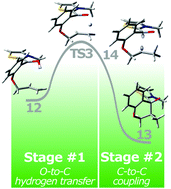An ELF analysis of the C–C bond formation step in the N-heterocyclic carbene-catalyzed hydroacylation of unactivated C–C double bonds
Abstract
The changes in electron-density along the C–C bond-formation step in the

* Corresponding authors
a
Departamento de Química Orgánica, Universidad de Valencia, Dr Moliner 50, E-46100 Burjassot, Valencia, Spain
E-mail:
domingo@utopia.uv.es
The changes in electron-density along the C–C bond-formation step in the

 Please wait while we load your content...
Something went wrong. Try again?
Please wait while we load your content...
Something went wrong. Try again?
L. R. Domingo, J. A. Saéz and M. Arnó, RSC Adv., 2012, 2, 7127 DOI: 10.1039/C2RA21042H
To request permission to reproduce material from this article, please go to the Copyright Clearance Center request page.
If you are an author contributing to an RSC publication, you do not need to request permission provided correct acknowledgement is given.
If you are the author of this article, you do not need to request permission to reproduce figures and diagrams provided correct acknowledgement is given. If you want to reproduce the whole article in a third-party publication (excluding your thesis/dissertation for which permission is not required) please go to the Copyright Clearance Center request page.
Read more about how to correctly acknowledge RSC content.
 Fetching data from CrossRef.
Fetching data from CrossRef.
This may take some time to load.
Loading related content
